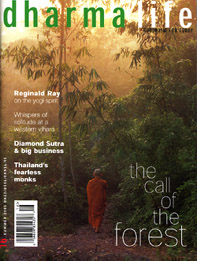The New Buddhism
The Western Transformation of an Ancient Tradition
James William Coleman
Oxford University Press, 2001
$25 h/b (US only)
As the title suggests, James Coleman, a professor of sociology of religion and a long-time practitioner of Zen, argues that Buddhism has undergone important transformations in its migration to the West. The West about which Coleman talks most in this book is the United States, although he does make occasional references to Buddhism in Canada and the UK. The forms of Buddhism about which he has the most to say are those that fall into one of four categories: Tibetan Buddhism, Zen, Vipassana and various non-sectarian Buddhist movements. It is under the rubric of non-sectarian that Coleman treats the FWBO, although he says that it is in many ways quite different from the typical non-sectarian Buddhist group.
Coleman's study excludes the mostly ethnic forms of Buddhism that have taken root in the West through the immigration of Asian populations. Also excluded is Soka Gakkai International, an exclusion that Coleman justifies on the grounds that SGI is so different in so many ways from other Buddhist sects that it deserves to be studied as a movement in itself. There is no doubt that had Coleman included SGI, the New Buddhism that he describes would have looked different from that outlined in this study.
The heart of Coleman's study is a questionnaire that he distributed to seven different Buddhist organisations in the US. Some of those who responded to the survey were then interviewed privately. The questionnaire was answered by 353 people, coming from two Zen centres, two Tibetan centres, two Vipassana groups and one non-sectarian group called the White Heron Sangha. While most of Coleman's data come from his survey and interviews, he also draws on a wide range of literature on the specific topics that he discusses.
When one considers the range of Buddhist organisations that Coleman chose to include and to exclude, it is perhaps not surprising that his survey shows that the typical New Western Buddhist is highly educated (51 per cent of his respondents have postgraduate degrees), relatively affluent, professional (the two best represented professions being academia and psychotherapy), white, with an average age of 46, a strong orientation towards the political left and slightly more likely to be female than male. Also not surprisingly, given this sample group, Coleman finds that over 90 per cent of the Buddhists surveyed regard regular meditation and retreats to be the most important Buddhist practices, with ritual and social services regarded as important practices by far fewer practitioners. Indeed, says Coleman, the tendency to see meditation as the soul of Buddhist practice is one of the features that distinguishes the New Buddhism of the West from the traditional Buddhism of Asia.
Other features of the New Buddhism, according to Coleman, are a pronounced resistance to organisational hierarchy and to authority figures, and a strong tendency to see family and secular careers, rather than monasteries, as ideal places for serious Dharma practice. Despite this tendency to seeing family life as a rich opportunity for spiritual transformation (in what Robert Aitken Roshi has called 'family practice'), Coleman also reports that a good many western Buddhists experience considerable personal conflict as they try to balance the needs of a family with finding time for the meditation they see as essential to healthy Buddhist practice.
Another important feature of the New Buddhism evolving in the West, says Coleman, is an increasing comfort with mixing Buddhist theories and practices, rather than holding to a single tradition in its putatively pure Asian form. Thus one finds western followers of Tibetan Buddhism reading the Pali canon and Zen classics, and Zen practitioners reading the Pali canon and reading about (and sometimes even doing) Tibetan visualisation practices. This willingness to mix traditions is not confined to drawing on Buddhist sources. Coleman also reports a readiness to combine Buddhist teachings and practices with Christian, Jewish, Sufi, Taoist and shamanistic practices, not to mention ideas from independent thinkers, such as Krishnamurti and a wide range of psychotherapists.
I was interested to learn that a significant number of people who regularly attend events at Buddhist centres for many years choose not to identify themselves as Buddhists at all, while a rather significant percentage of those who do identify themselves as Buddhists also identify themselves as Christians or Jews or as having no religion at all; this, of course, means that a certain number of western Buddhists choose not to see Buddhism as a religion.
To my mind the most insightful chapter of Coleman's book is his beautifully balanced account of sex, power and conflict. Far from a lurid account of various scandals, Coleman offers a thought-provoking series of reflections of various perspectives on these potentially troubling issues. Like the rest of the book, this chapter is informative and measured, an excellent example of the Middle Path he seeks to describe.
Dayamati (Richard Hayes) is Associate Professor of Sanskrit and Indian Buddhist philosophy at McGill University, Quebec



